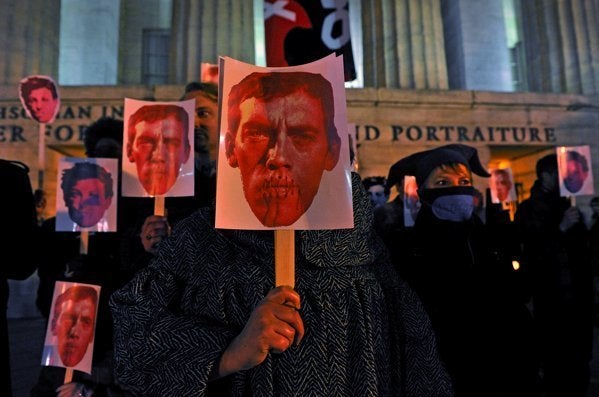
The differences between the censorship controversy at the Smithsonian and the attempts to manufacture a censorship controversy at the Los Angeles Museum of Contemporary Art could not be more diametrically opposed. The rights of curators to exercise their free speech hangs in the balance of both debates, though.
When John Boehner and some conservative congressman demanded that the National Portrait Gallery remove A Fire in My Belly by the late David Wojnarowicz from the exhibit Hide/Seek: Difference and Desire in American Portraiture, the Smithsonian Institution (which directs the NPG) capitulated quite rapidly. This signals a coming dark cloud. An uneasy truce has held over public art exhibitions in the past few decades; a clear sign that offensive material might be present was posted and the family values wolves were held at bay. But with recent electoral gains and a new hypersensitivity about spending, this surprise attack on the arts signals a new front in the no longer dormant cultural wars. Content of any publicly funded space will be scrutinized and condemned on moral as well as fiscal grounds. The brave Andy Warhol Foundation, led by Joel Wachs, has announced that it will be cutting off all grants to any Smithsonian-associated venue. That non-profit groups regularly add funding to public arts programs always escapes mention by the lunatic censorship brigade. Any chance Glenn Beck thanks the Warhol Foundation for the $375,000 they donated to Smithsonian programming in 2010? Suffice to say, the pyrrhic victory of renewed attention to the Wojnarowicz work will come at an ultimately high price: The ghost of Jesse Helms is alive in hundreds of emboldened public officials and inspiring them to kill curatorial freedom and government art neutrality. Wonder how many of them are inconsistently backing net neutrality.
Meanwhile, in sunny Southern California, MOCA director Jeffrey Deitch wisely altered the curation of a coming survey of street art prior to the show's opening. MOCA whitewashed a potentially divisive mural by an artist named only Blu. The blogs and YouTubes burst forth with First Amendment martyrdom, cries of censorship and scathing rants against the museum's decision. The wall of the museum in question was being painted with a repeated pattern of wooden coffins (copyright pic at this link, gotta love how the critics of "the system" milk it better than anyone). An oversized dollar bill was draped on each in lieu of the traditional flag there to honor a fallen veteran. With all the wit of a college newspaper editorial cartoon, the mural was not whitewashed because of its infantile attempt at protest. This north wall of the Geffen Contemporary wing of MOCA straddles an expansive parking lot. The lot is across the street from the Department of Veterans Affairs. But even closer than that, a mere thirty feet away from this North Wall, stands the only official United States memorial to its fallen Asian American Servicemen.
Without even considering the current political climate, suppose you were a museum director in New Orleans and a street artist had made a mural of soldiers drowning ten yards away from a Hurricane Katrina memorial. Does that help with your empathy in this situation? Obviously Deitch had empathy for the population of the Little Tokyo community and how they might interpret a commentary on the sacrifice of their late bothers and fathers.
Some street art fans are crying about the First Amendment violations in this whitewashing but are not considering two things. Do MOCA's curators have a First Amendment right to make the best show possible? Is curating not an artistic process? If a movie director decides that scene in a film detracts from the overall picture and he cuts it, is he censoring the actors who lose screen time as a result? A ratings board or government agency demanding that movie have a scene cut is censorship. The decision to get rid of an artwork that would detract from the overall show is a curatorial decision. Not only is the whitewashing at MOCA not censorship, it is both a brave move to make a show better in the face of controversy as well as to be sensitive on behalf of the local community, something that a shock-and titillation-centric art world is not really known for.
In a brilliant effort to combat the Washington DC censorship at the Smithsonian, Mike Blasenstein stood at the entrance to Hide/Seek with an iPad playing the pulled Wojnarowicz video. According to the Washington Post, Blasenstein believes he has been banned for life. Meanwhile, L.A. being L.A., the spotlight-seeking opportunists crawl out of woodwork to insist Deitch is a West Coast Boehner. In DC, Blasenstein wanted to interact with museum visitors. L.A. is street art cheerleaders just want to interact with the media, even if they have to whitewash any curatorial right to free speech in order to be heard. The controversy in L.A. will die down, the street art show will go on and the blowhards will pontificate about the constitution. When you finally do tire of the street artist defenders crying about the First Amendment, just bring up the Fifth Amendment. Like impassioned defenses of free speech, some Fifth Amendment property rights activists would argue that when a street artist trespasses on your property to make art, you can shoot and kill the aspiring Blu wannabe. I would never advocate something this harsh, but if you do shoot the artist, don't whitewash the "artwork"... that might be censorship.
